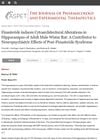Search
for
Sort by
Research
210-240 / 1000+ resultsresearch Oral Administration of TrkB Agonist, 7,8-Dihydroxyflavone Regenerates Hair Cells and Restores Function after Gentamicin-Induced Vestibular Injury in Guinea Pig

research Bioprinting of Hair Follicle Germs for Hair Regenerative Medicine
The study developed a new way to create hair-growing tissue that can help regenerate hair follicles and control hair growth direction.

research Large-Scale Preparation of Hair Follicle Germs Using a Microfluidic Device
A new method using a microfluidic device can prepare hair follicle germs efficiently for potential use in hair loss treatments.

research Overexpression of Activin A in the Skin of Transgenic Mice Reveals New Activities in Epidermal Morphogenesis, Dermal Fibrosis, and Wound Repair
Overexpression of activin A in mice skin causes skin thickening, fibrosis, and improved wound healing.

research Hair Follicle Regeneration Using Grafted Rodent and Human Cells
Grafted rodent and human cells can regenerate hair follicles, but efficiency decreases with age.

research Recent Advances in Biodegradable and Biocompatible Synthetic Polymers Used in Skin Wound Healing
New synthetic polymers help improve skin wound healing and can be enhanced by adding natural materials and medicines.

research Wound Healing, Cutaneous Therapy, Hair
A device was made in 2008 to measure hair loss severity. Other findings include: frizzy mutation in mice isn't related to Fgfr2, C/EBPx marks preadipocytes, Cyclosporin A speeds up hair growth in mice, blocking plasmin and metalloproteinases hinders healing, hyperbaric oxygen helps ischemic wound healing, amniotic membranes heal wounds better than polyurethane foam, rhVEGF165 from a fibrin matrix improves tissue flap viability and induces VEGF-R2 expression, and bFGF enhances wound healing and reduces scarring in rabbits.

research Strategies for Optimizing Acute Burn Wound Therapy: A Comprehensive Review
Advanced techniques and technologies can improve burn wound healing, but more research is needed.

research Finasteride Induces Cytoarchitectural Alterations in Hippocampus of Adult Male Wistar Rat: A Contributor to Neuropsychiatric Effects of Post-Finasteride Syndrome
Finasteride may cause memory problems by damaging the hippocampus.

research Follicle-Innervating Aδ-Low Threshold Mechanoreceptors Organize Through a Population-Dependent Mechanism
Mouse touch-sensitive nerve cells adjust their connections based on competition with other similar cells.
research Impact of Stem Cells on Reparative Regeneration in Abdominal and Dorsal Skin in the Rat
Abdominal skin heals faster than dorsal skin because it has more stem cells.

research RE-ORGA, a Korean Herb Extract, Can Prevent Hair Loss Induced by Dihydrotestosterone in Human Dermal Papilla Cells
RE-ORGA, a Korean herb extract, may help prevent hair loss.

research Protective Effect of DA-9401 in Finasteride-Induced Apoptosis in Rat Testis: Inositol Requiring Kinase 1 and c-Jun N-Terminal Kinase Pathway
Finasteride helps female-pattern hair loss.

research Colon Cancer Stem Cells: Promise of Targeted Therapy
Targeting colon cancer stem cells might lead to better treatment results.

research Protective Effect of DA-9401 in Finasteride-Induced Apoptosis in Rat Testis: Inositol Requiring Kinase 1 and c-Jun N-Terminal Kinase Pathway
DA-9401 helps protect rat testis from finasteride damage.

research The Role of 3Rs in the Age of One Health: Where We Are and Where We’re Going
Innovative methods are reducing animal testing and improving biomedical research.

research Improved Humoral Immunity and Protection Against Influenza Virus Infection With a 3D Porous Biomaterial Vaccine
A new vaccine using a porous scaffold boosts immunity and protects against the flu better than traditional methods.

research Combined Drug Triads for Synergistic Neuroprotection in Retinal Degeneration
Using three different drugs together may better treat eye diseases like glaucoma and macular degeneration.

research Keratin-Mediated Hair Growth and Its Underlying Biological Mechanism
Keratin injections can promote hair growth by affecting hair-forming cells and tissue development.

research Skin CD4+ Memory T Cells Exhibit Combined Cluster-Mediated Retention and Equilibration with the Circulation
Memory T cells in the skin balance staying put and moving into the blood, clustering around hair follicles, and increasing in number after infection.

research Heat-Killed Lacticaseibacillus Paracasei GMNL-653 Ameliorates Human Scalp Health by Regulating Scalp Microbiome
Shampoo with heat-killed Lacticaseibacillus paracasei GMNL-653 improves scalp health and hair growth by changing scalp bacteria.

research Vascular Endothelial Growth Factor Protects CD200-Rich and CD34-Positive Hair Follicle Stem Cells Against Androgen-Induced Apoptosis Through the Phosphoinositide 3-Kinase/Akt Pathway in Patients With Androgenic Alopecia
A substance called Vascular Endothelial Growth Factor can protect certain hair follicle stem cells from damage caused by androgens, suggesting a new possible treatment for hair loss.
research Finasteride Interferes with Prostaglandin-Induced CatSper Signalling in Human Sperm
Finasteride may affect male fertility by interfering with specific sperm signaling.

research Mechanical and Biological Properties of Keratose Biomaterials
Keratose, derived from human hair, is a non-toxic biomaterial good for tissue regeneration and integrates well with body tissues.

research Current Protocols: Alopecia Areata Mouse Models for Drug Efficacy and Mechanism Studies
The C3H/HeJ mouse model is useful for studying and testing treatments for alopecia areata.

research Development and Prospects of Organ Replacement Regenerative Therapy
Scientists have made progress in creating replacement teeth, hair, and glands that work, which could lead to new treatments for missing teeth, baldness, and dryness conditions.

research A Nude Mouse Model of Hypertrophic Scar Shows Morphologic and Histologic Characteristics of Human Hypertrophic Scar
Nude mice with grafted human skin developed scars similar to human hypertrophic scars.

research Peroxisome Proliferator-Activated Receptors (PPARs) and PPAR Agonists: The Future in Dermatology Therapeutics?
PPAR agonists show promise for skin conditions but need more research before being a main treatment.

research Dermal Fibroblasts in Cutaneous Development and Healing
Skin cells called dermal fibroblasts are important for skin growth, hair growth, and wound healing.